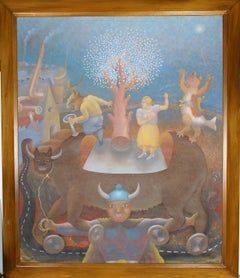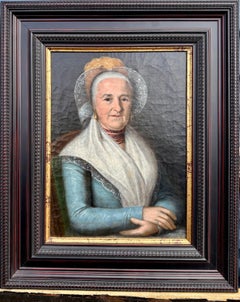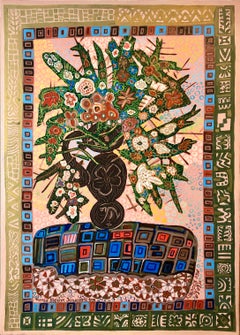Maximino Javier Paintings
Mexican, b. 1948
Maximino Javier (b. 1948) is a renowned Oaxacan artist recognized for his exploration of Latin American mythology in his art. He was a founding member of the Rufino Tamayo Workshop in Oaxaca, where he developed a distinct artistic approach emphasizing technical precision and cultural storytelling. His work often blends popular traditions with mythical narratives, employing meticulous use of color, form, and composition to transform folkloric themes into complex artistic statements.
Javier's art is known for its fantasy-oriented and whimsical nature, often featuring anthropomorphic elements and imaginative compositions, as seen in the expressive moon and stylized figures. His works frequently explore themes from Latin American mythology and the intricate relationship between humans and nature, reflected in the depiction of the musician and the moon in a mystical setting.
Unmistakable Iconography: Javier developed a unique and recognizable iconography, which is evident in the distinct forms and imaginative portrayal of characters and elements in these pieces, matching his unique aesthetic.to
1
Overall Width
to
Overall Height
to
1
1
1
1
1
1
1
1
1
1
1
1
1
5
784
712
707
702
1
1
Artist: Maximino Javier
Bull on Wheels (Dancing)
By Maximino Javier
Located in Long Island City, NY
An Oaxacan School oil painting by Maximino Javier from 1983. A whimsical scene of anthropomorphic figures. Framed in stained wood frame, signed in lower left corner.
Artist: Maximino Javier, Mexican (1948 - )
Title: Untitled - Bull on Wheels...
Category
1980s Folk Art Maximino Javier Paintings
Materials
Canvas, Oil
Price Upon Request
Related Items
19th century American Folk Art of a Seated Lady in her Sunday best clothes
Located in Woodbury, CT
Unknown Artist (American School, 19th century)
Portrait of a Lady in Blue, c. 1835–1850
Oil on canvas
This painting is unsigned
This quietly elegant portrait captures a mature woman...
Category
1850s Folk Art Maximino Javier Paintings
Materials
Canvas, Oil
Israeli Folk Art Bright Colorful Naive Floral Painting, Mod Flowers in Vase
By Menia Litvak
Located in Surfside, FL
A fantastic vase of bold colorful flowers. signed and dated in Hebrew and English, Jerusalem 1989.
Litvak's life as an artist started in 1976 when he left Kishinev (Bessarabia) for Israel...
Category
20th Century Folk Art Maximino Javier Paintings
Materials
Canvas, Oil, Acrylic
"Overholser Family, 1890, Sterling, Illinois" Streeter Blair, 1949 Painting
Located in New York, NY
Streeter Blair
Overholser Family, 1890, Sterling, Illinois, 1949
Signed, titled, and dated lower left
Oil on canvas
8 x 10 inches
Primitive painter St...
Category
1940s Outsider Art Maximino Javier Paintings
Materials
Canvas, Oil
“Boy with Blue Birds”
By Agapito Labios
Located in Southampton, NY
Original oil on canvas folk art painting by the well known Mexican artist, Agapito Labios. Signed lower right. Circa 1935. Condition is very good. ...
Category
1930s Folk Art Maximino Javier Paintings
Materials
Canvas, Oil
Contemporary Atmospheric Black & White Monochrome Landscape Wilderness Painting
By Mark Thompson
Located in Preston, GB
Contemporary Atmospheric Black & White Monochrome Landscape Wilderness Painting by 20th Century Artist. Mark Thompson is a seasoned professional pa...
Category
Early 2000s Outsider Art Maximino Javier Paintings
Materials
Canvas, Paint, Cotton Canvas, Oil
$6,014 Sale Price
20% Off
H 33 in W 46 in D 2 in
Ernst Philip De Fine Licht, Helsingborg Old Town Hall
Located in Cheltenham, GB
This charming Lowry-esque late 19th-century oil painting by Swedish artist Ernst Philip De Fine Licht (1855-1929) depicts the old town hall at Helsingborg, Sweden. De Fine Licht was ...
Category
1870s Folk Art Maximino Javier Paintings
Materials
Oil, Canvas
$3,641
H 30.5 in W 41.5 in
Early 20th-Century English School, John Lovibond & Sons, Cannon Brewery, Fulham
Located in Cheltenham, GB
This charming early 20th-century English School oil painting depicts the Cannon Brewery at North End, Fulham, owned by John Lovibond & Sons Ltd.
Founded in 1867, the brewery was bui...
Category
Early 1900s Folk Art Maximino Javier Paintings
Materials
Oil, Canvas
Fantastic Village Scene Modern Irish Magic Realism Oil Painting
By Philip Castle
Located in Surfside, FL
Philip Castle was an Irish Painter and husband to artist Barry Castle
He is rarely exhibited. His detailed, meticulous work took a long time to complete and his output was quite li...
Category
20th Century Folk Art Maximino Javier Paintings
Materials
Canvas, Oil
$3,000
H 21.5 in W 25.75 in D 0.66 in
Jewish Folk Art Painting "Blessed is the Healer of the Sick" Rabbi at Prayer
Located in Surfside, FL
Signed A.H. Okun
Genre: Judaica
Subject: People
Medium: Oil
Surface: Canvas
Dimensions: 11" x 14"
Dimensions w/Frame: 15" x 19 3/4"
Category
Mid-20th Century Folk Art Maximino Javier Paintings
Materials
Canvas, Oil
Navigator, bright color oil painting of figure, boats, water
By Stephen Basso
Located in Brooklyn, NY
*ABOUT Stephen Basso
Stephen Basso's highly original pastels and oil paintings are romantic, yet thought provoking fantasies. His whimsical works are alive with boundless imagina...
Category
2010s Outsider Art Maximino Javier Paintings
Materials
Canvas, Oil
$4,500
H 60 in W 52 in D 1.5 in
Mid 19th Century Folk Art Hunting Scene, Landscape, Animal and Figurative, 1852
Located in Doylestown, PA
This mid 19th Century, 25" x 30", oil on canvas, Folk Art hunting scene was painted in 1852, and signed and dated by an illegible artist. It is framed in a reproduction wood frame.
Category
1850s Folk Art Maximino Javier Paintings
Materials
Canvas, Oil
$7,000
H 32 in W 37 in D 1.5 in
Rapunzel by the Sea, fairy tale narrative, colorful whimsical fantasy
By Stephen Basso
Located in Brooklyn, NY
Rapunzel figure narrative, colorful
*ABOUT Stephen Basso
Stephen Basso's highly original pastels and oil paintings are romantic, yet thought provoking fantasies. His whimsical w...
Category
2010s Outsider Art Maximino Javier Paintings
Materials
Canvas, Oil
$2,000
H 40.01 in W 30.01 in D 0.99 in
Maximino Javier paintings for sale on 1stDibs.
Find a wide variety of authentic Maximino Javier paintings available for sale on 1stDibs. If you’re browsing the collection of paintings to introduce a pop of color in a neutral corner of your living room or bedroom, you can find work that includes elements of blue and other colors. You can also browse by medium to find art by Maximino Javier in canvas, fabric, oil paint and more. Not every interior allows for large Maximino Javier paintings, so small editions measuring 40 inches across are available. Customers who are interested in this artist might also find the work of Jose Maria de Servin, Jaimendes, and Purvis Young. Maximino Javier paintings prices can differ depending upon medium, time period and other attributes. On 1stDibs, the price for these items starts at $125,000 and tops out at $125,000, while the average work can sell for $125,000.


